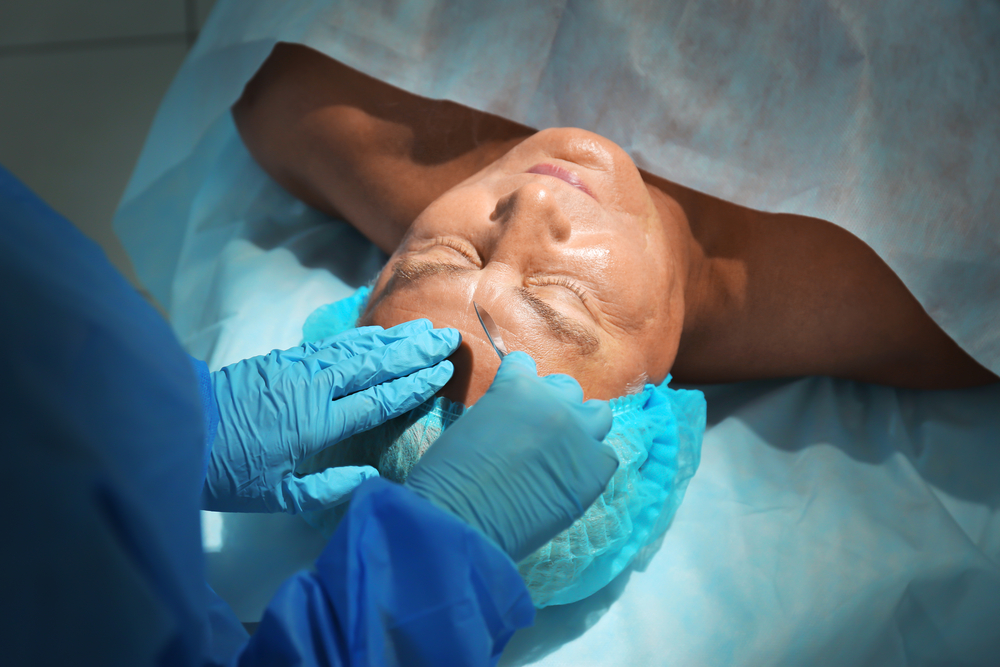With so many different facelift options available, choosing the one that lasts the longest and best suits your needs can be challenging. These basic tips will help prolong your facelift’s rejuvenating benefits, no matter what type of procedure you choose to undergo.
If you’re interested in getting a facelift, then you’ve no doubt also been wondering about its longevity and final results. Yet despite its popularity as a cosmetic procedure, there’s no simple answer to how long a facelift will last. It depends in great part on your cosmetic surgeon’s skill, the health of your skin prior to the facelift procedure, and the type of facelift that you get. Thankfully, there are strategies you can employ that will improve and prolong the results of your surgery. The following facelift recovery tips will keep you looking younger for longer.
Types of Facelifts and Their Lifespans
At its heart, the facelift is a form of plastic surgery that seeks to firm up the skin in the face and neck region to provide a more youthful appearance. Although true facelifts involve incisions followed by stretching the skin, the term “facelift” has been broadly applied to most surgical or nonsurgical procedures that strive for similar results, giving you numerous options when considering the best procedure for you.
Creating a list of facelift techniques is complicated. A quick Google search will yield dozens of terms for different types of facelift procedures. Some of these terms overlap. Others vary from surgeon to surgeon. As Beverly Hills plastic surgeon Dr. Brent Moelleken puts it, “one surgeon’s SMAS operation is equivalent to another doctor’s minilift.”
One surgeon’s SMAS operation is equivalent to another doctor’s minilift. ~Dr. Moelleken
The procedures listed here are among the most common and well-known. They should give you some idea of what might be available to you and how long the results are expected to last. Nevertheless, you should consider discussing more nuanced options with the surgeon of your choice during your initial consultation.
Full Facelift
This is the traditional facelift surgery. It involves a long incision made near the hairline followed by stretching the skin, rearranging the fat, and often lifting the facial muscles. Full facelifts are typically expected to last around five years. However, that is a gross estimate. Every facelift is unique, and results can vary by several years in either direction.
Mini Facelift
The mini facelift, also called an S-Lift, follows similar steps as the full facelift. However, it involves a smaller, s-shaped incision around the ears. The results primarily center on the neck and chin area, lifting the lower face as opposed to the whole face. This procedure is not to be confused with the neck lift, which focuses solely on the neck region.
The mini facelift has grown dramatically in popularity as it addresses the problem areas that inspire many people to get facelifts while also having a shorter recovery period, a detail that earned it the nickname “weekend facelift.” Unfortunately, that’s not all that’s shorter. Mini facelifts typically last between two and five years.
Mid Facelift
This facelift surgery does exactly what it’s name describes; it focuses on the mid-portion of the face. Mid facelifts target the eyes and cheeks, seeking to reduce bagginess around the eyes and elevate the skin on the cheekbones. Like s-lifts, mid facelifts involve smaller incisions. Possibly due to the target areas, this facelift has a somewhat longer shelf life, lasting from five to seven or even five to ten years, depending on who you ask. Some patients also opt to undergo eyelid surgery as an alternative to lift the lower eyelids.
Deep Plane Facelift
Emphasis is on the word “deep.” The deep plane lift goes deeper than traditional facelifts, working beneath the muscle in the cheeks to better elevate them. The end results of deep plane facelifts are more dramatic and longer-lasting than other types of facelifts. Sources vary, saying results last from five to ten or even ten to fifteen years.
Thread Lift
This unconventional facelift surgery involves threads that are inserted into the skin and used to pull it tighter. The threads then remain to hold the new shape of the skin together. Thread lifts are less invasive than traditional facelifts. However, they’re longevity is wildly inconsistent and generally not very long. Thread lifts last between six months and two and a half years depending on your skin texture.
Liquid Facelift
Liquid facelifts are not true facelifts. They are non-surgical injections involving fillers and Botox. However, these injectable treatments are referred to as “facelifts” because they strive for similar results, reducing fine lines, deep folds, vertical folds, and providing a younger appearance. Liquid facelifts are said to last a year or two, but results can vary depending on the number of injections the patient has had, their age, and other factors.
Laser Facelift
This is another type of facelift that is not technically a facelift. It involves infrared lasers that heat the collagen beneath the surface of the skin. The heated collagen tightens and makes the skin look younger. This procedure, also known as laser skin tightening, is typically done in installments of approximately six treatments, with its final result yielding a rested appearance. It is expected to last up to two years. Laser’s are also beneficial for patients looking to reduce the appearance of acne scars.
Vampire Facelift
This relatively new and unconventional procedure has been getting a lot of attention in the media lately and as such is worth mentioning here. Vampire facelifts involve taking blood from a patient’s arm, spinning it in a centrifuge to separate out the platelets (a process known as “blood spinning”), and injecting it into a patient’s face. Blood spinning has been used to treat a variety of maladies based on the notion that blood platelets contain regenerative qualities and, when concentrated and injected into problem areas, can speed up the healing process.
Vampire facelifts specifically function on the principle that these regenerative qualities stimulate collagen growth and make the skin appear naturally younger. Results are expected to last from one to two years.
Regardless of the specific procedure you undergo, there are some simple universal facelift recovery tips you can follow to ensure the results of your procedure last as long as possible.
1. Protect Your Skin From the Sun
This can’t be overstated. Damage caused by sun exposure ages skin prematurely. The UV rays in direct sunlight discolor skin, giving it a patchy look, a feature sometimes known as age or liver spots. They also damage the collagen and elastin located beneath the surface of the skin, both of which are needed for skin to appear smooth.
Unfortunately, you can’t do anything about sun damage that occurred prior to your cosmetic surgery. You can, however, prevent further damage and prolong the positive results of that surgery. Use sunscreen every day. Depending on your needs, you might even get clinical grade sunscreen from your doctor. Otherwise, look for something that is at least SPF 30 and contains zinc oxide.
In addition to regular sunscreen applications, limit your exposure to direct sunlight with hats and umbrellas. Of course, this doesn’t mean you need to say goodbye forever to your days of tanning at the beach, only that you need to be smart about your degree of exposure to the sun and prioritize your skin over your tan. Remember, you don’t need a sunburn to see sun damage. This is probably the single most essential facelift recovery tip, as sun damage is largely irreversible.
2. Eat Healthy
It’s no mystery that what we put into our bodies can show up on our face. A healthy diet, complete with greens, bright fruits and vegetables, complex carbs, and meat can actually help your skin look younger by keeping it nourished and improving its elasticity.
- Vitamin C in particular has rejuvenating qualities, encouraging collagen production which in turn improves skin strength and structure. In doing so, it reduces wrinkles and makes your skin feel smoother. Try to get your Vitamin C from oranges, red peppers, kale, and other direct, natural sources.
- Vitamin E is another major player when it comes to skin health. It works to smooth over scars and rough skin, helping skin heal more effectively. Eat nuts and spinach to up your Vitamin E intake.
- Vitamin A helps skin heal itself and stay smooth and moist. You can find vitamin A in everything from sweet potatoes and squash to fish and fresh fruits.
- Finally, all of the B vitamins, known collectively as Vitamin B Complex, aid the production of new skin cells. Turn to brightly colored fruits and vegetables for these nutrients.
Of course, eating right is only part of the battle. For a truly skin friendly diet, you need to make sure you drink enough water. Well hydrated skin is stronger, smoother, and younger. Make a good large, healthy dose of water part of your daily diet. Physical activity to maintain a healthy body weight will also influence the health of your skin by reducing excess fat in the facial area.
3. Don’t Smoke
As if there weren’t already enough good reasons not to smoke, here are a few skin related ones to help you kick the habit. Nicotine dries your skin out, making it age more rapidly. Nicotine also interferes with the healing process, making smoking particularly harmful just after surgery.
In fact, many facial plastic surgeons ask that if you are intent on continuing the habit, you stop during your recovery time in order to ensure proper healing. They note that nicotine could not only delay the healing process but also cause tissue death. It’s fair to say that smoking heavily while recovering from facial plastic surgery could do more than just shorten the lifespan of your facelift. It could cause irreparable damage. Not to mention lung cancer in the future!
However, if you’re fully healed and thinking of picking your smoking habit back up, remember that nicotine reduces Vitamin A and carbon monoxide affects Vitamin C levels, negating all that healthy eating and shortening the lifespan of your youthful new look.
4. Medical Grade Skin Care
Medical grade skin products can only be acquired through a physician, but don’t let that scare you away from giving them a try. Their limited availability is largely due to their effect on deeper layers of the skin. This makes them not only more successful at healing and rejuvenating skin, but also riskier than your typical over-the-counter products.
Ordinary skin care products work on the epidermis, or outer layer, of the skin. Medical grade skincare products work on the middle layer, where collagen and elastin are located, and the deepest layer, where new skin cell growth occurs. While this definitely makes them more effective, it also means that they are heavy duty. Deeper facial tissues are more sensitive, and overuse of these products can result in negative reactions that could actually damage the skin.
Talk to your cosmetic surgeon about medical grade skincare products and other skin treatments that suit your needs. However, make sure you follow the clinical instructions to the letter in order to avoid too much of a good thing.
5. Non-Surgical Boosters
Healthy lifestyle choices and medical grade skincare products are only part of the battle.Talk to your cosmetic surgeon about non-surgical treatments that can help prolong the effects of your facelift. Many of the aforementioned facelift procedures can act as supplements that support surgical facelifts. Liquid and laser facelifts in particular can help increase moisture and skin elasticity, keeping you looking younger for longer.
When Your Facelift Starts to Go
It will happen eventually. You’ll notice that your skin is sagging in a familiar way. The space under your eyes will start to hollow out. Your skin will look thinner and dryer overall. This is nothing to be afraid of; dry and loose skin are part of the natural facial aging process. However, it’s also a sign that your efforts to look your best are starting to wane. Many people in this position opt for another facelift surgery. Of course, not everybody is able to afford going under the knife every five or so years. Which is all the more reason to follow the above steps and allow your facelift to provide the long-lasting results possible, putting off this dreaded moment for a long time to come.









